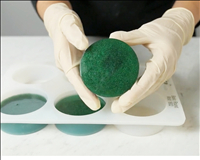Melt and Pour Soap Basics Part 1Updated a year ago
Melt and Pour (MP) Soap Base is a man-made, commercially produced, water-soluble compound formulated for the purpose of cleansing the body. It comes in varying shades, depending on the formula and additives used. You can typically find white bases, clear bases, green tinted bases and yellow tinted bases. Natural vegetable oils are saponified and used as a base for the MP Soap. Unlike traditional soap making, the saponification process is complete and no curing time is necessary. Working with MP Soap Base is great for those that don’t want to handle sodium hydroxide (lye).
Natural vegetable oils are saponified and used as a base for the MP Soap. Unlike traditional soap making, the saponification process is complete and no curing time is necessary. Working with MP Soap Base is great for those that don’t want to handle sodium hydroxide (lye).
When the soap is commercially produced, additives are incorporated into the formula to improve the base’s clarity, lather and craftability. MP Soap Base is a unique soap because it is specifically formulated to be heated, melted and solidified without changing the original qualities of the base.
Natural vegetable oils have different fatty acid chain lengths and each different chain length contributes to different characteristics of the soap. Shorter fatty acid chain lengths are more water-soluble and produce large bubbles, quick lather, and a softer bar of soap. Longer fatty acid chain lengths are less water-soluble and produce smaller tight bubbles and a harder bar of soap. Different manufacturers use different fatty acids in their individual MP Soap Base formulas. The following are the most common fatty acids used, including chain length:
Lauric Acid: C-12
Myristic Acid: C-14
Palmitic Acid: C-16
Stearic Acid: C-18
PH is a measure of the acidity or alkalinity of a solution. Since MP Soap Base formulas can vary from manufacturer to manufacturer, so can the pH. The typical pH range of MP Soap Bases is 8 to 9. You need this higher pH to attract dirt, cleanse the skin, and rinse away the soap. Soap with a low pH can be soft and leave bathtub rings. Soap with a high pH can cause skin irritation. If you are ever curious about the exact pH of your soap, you can test the pH of your soap with strips and solutions found at many local pool stores.
Best Used and Expiration Dates
MP Soap does not have an expiration date because it will not go rancid. The high percentage of propylene glycol required to produce this type of base acts as a natural preservative. Most MP Soap Bases have a “Best Used” date. The Best Used date is important because MP Soap Base can lose water and dehydrate over time.
If you find yourself with dehydrated MP Soap Base you can try adding in liquid glycerin (at 5-10%) to make it usable.
Different manufacturers have different formulas and thus different melt points to their MP Soap Base formulas. The typical melt point for most MP Soap Bases on the market is 115º-125ºF.
To raise the melt point of your soap, you can add 3% palm stearic acid to the soap base. This will make the soap harder. Making this addition will likely cloud your base and decrease your lather, but is helpful when a higher melt point base is required. To add stearic acid, melt the stearic acid until liquid, which is approximately 160ºF. Melt the soap base to 150ºF. Blend the two together.
Note: Adding extra ingredients can reduce the lather of the final product, so keep this in mind when you are formulating.
If is very important to know the melt point of your MP Soap Base.
- Heating the base more than 30ºF above melt point may cause the soap to dehydrate and become prone to bloom.
- Heating the base more than 50ºF above melt point may cause the soap to become brittle, reduce lather, and turn yellow.
- Prolonged overheating of soap base will turn the base amber and produce a foul odor that may be difficult to mask with fragrance or essential oils.
- Selling soap at a hot outdoor show or displaying soap in a warm store window could result in the soap softening or melting.
- When mixing or combining different bases the overall melt point will change to the average of the bases mixed.